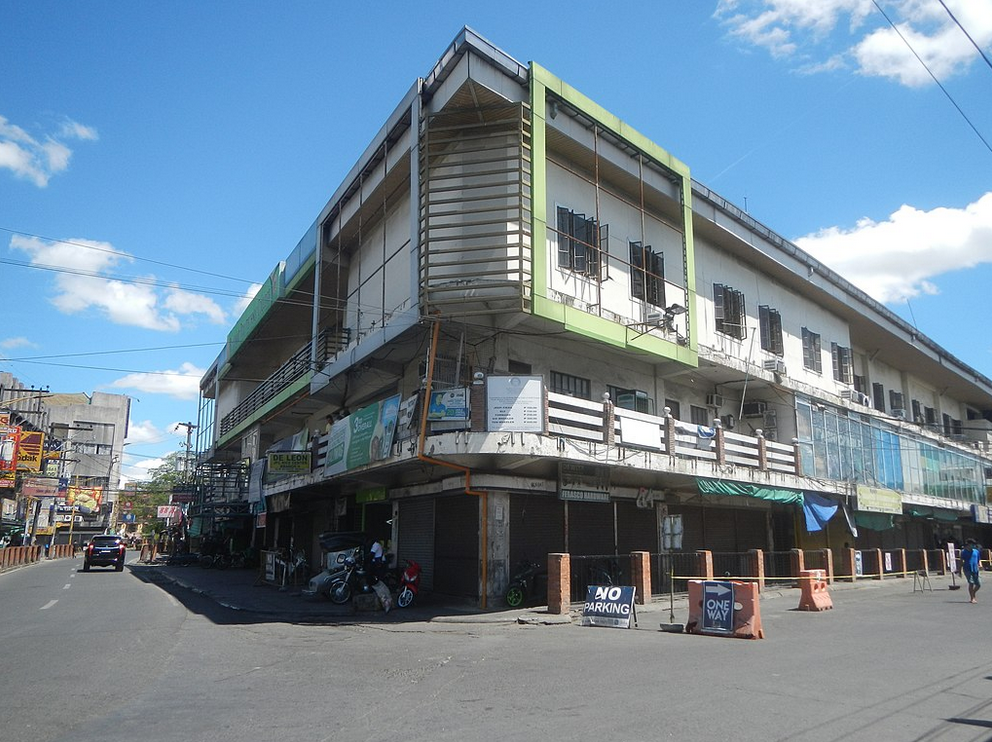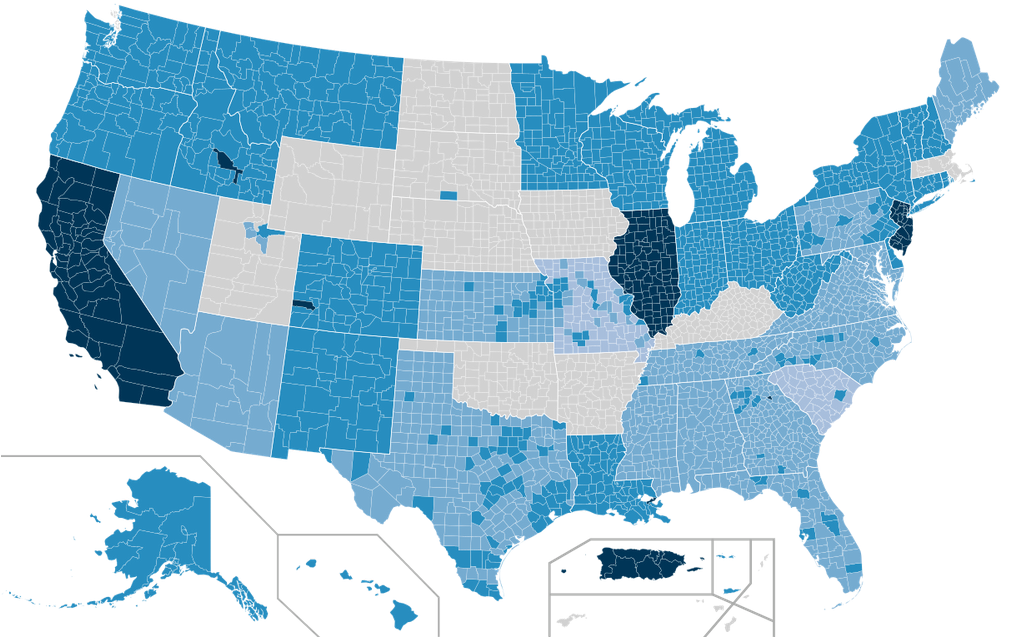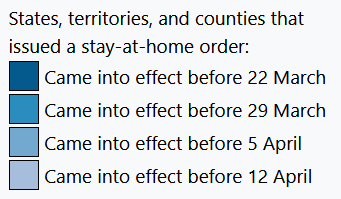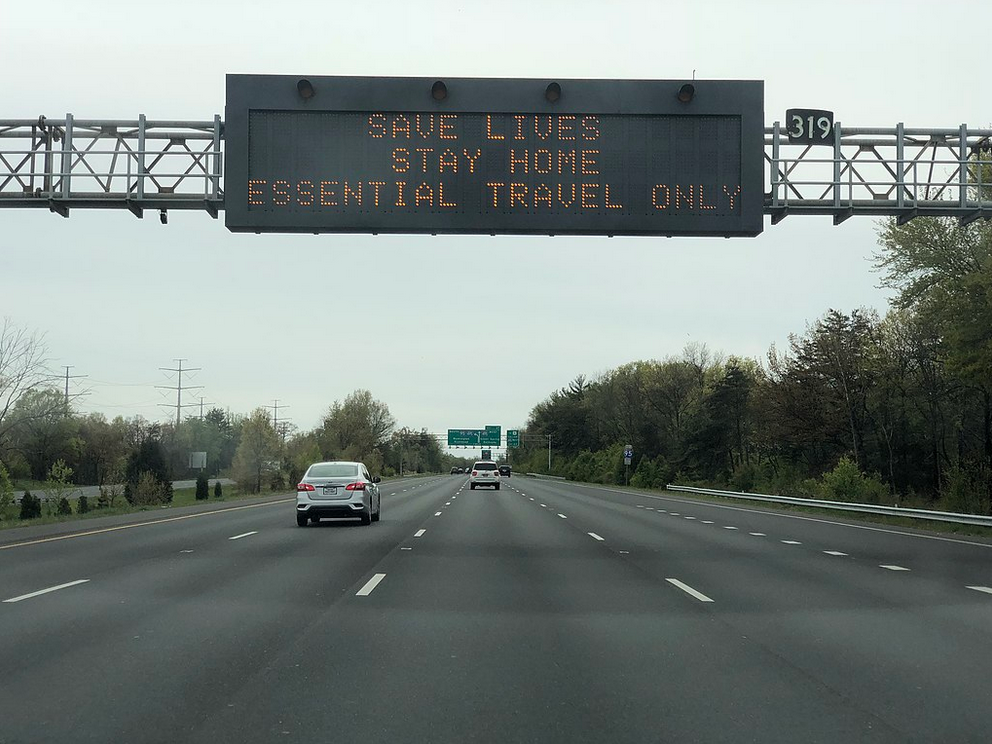There are worldwide curfews, quarantines, and similar restrictions (variously described as stay-at-home orders, shelter-in-place orders, shutdowns or lockdowns) related to the COVID-19 pandemic and established to prevent further spread of the severe acute respiratory syndrome coronavirus 2 (SARS-CoV-2), which causes COVID-19. Countries and territories around the world have enforced lockdowns of varying degrees. Some include total movement control while others have enforced restrictions based on time. Mostly, only essential businesses are allowed to remain open. Schools, universities and colleges have closed either on a nationwide or local basis in Template:Education statistics on the COVID-19 pandemic countries, affecting approximately Template:Education statistics on the COVID-19 pandemic per cent of the world's student population. All types of recreational venues and most public places have been affected.
- templateeducation
- worldwide
- movement control
1. Table of Pandemic Lockdowns
In the table pandemic lockdowns are defined as the shutdown of parts of the economy,[3] due to non-pharmaceutical anti-pandemic measures and are enforceable by law like:
- Closing of schools and kindergartens
- Closing of non-essential shops (shops and stores apart from food, doctors and drug stores)
- Closing of non-essential production
- Cancellation of recreational venues and closing of public places
- Curfews
- Stay-at-home orders and total movement control
These measures are considered to have caused the coronavirus recession in 2020.[4] The table does not contain:
- Measures with smaller economic impacts like:
- border closures
- social distancing measures and social movement restrictions
- travel restrictions.
- Other non-pharmaceutical anti-pandemic measures like mandatory quarantines after travel, self quarantine and social distancing measures
- Any measures which are voluntary rather than enforceable by law
The pandemic has resulted in the largest number of shutdowns/lockdowns worldwide at the same time in history.. By 26 March, 1.7 billion people worldwide were under some form of lockdown,[5] which increased to 3.9 billion people by the first week of April – more than half of the world's population.[6][7]
Restrictions first began in China,[8] with other countries in East Asia like Vietnam soon following it in implementing widespread containment measures. Much of Europe, North America and Africa took much longer to bring in tough measures. Lockdowns between and within nations are of varying stringency.[9]
By mid April, nearly 300 million people, or about 90 per cent of the population, were under some form of lockdown in the United States,[10] around 100 million in the Philippines,[11] about 59 million in South Africa,[12] and 1.3 billion were under lockdown in India; the largest of all lockdowns.Check the list of COVID-19 Hotspots or containment Zones of India.[13][14]
By the end of April, around 300 million people were under lockdown in various countries of Europe, including but not limited to Italy, Spain, France, and the United Kingdom; while around 200 million people were under lockdown in Latin America.[11]
2. Countries and Territories with Lockdowns
2.1. China
China, where the pandemic originated, was the first country to enforce the quarantine and lockdown of cities and later whole provinces, starting at the end of January. Although such measures are a very old tool of epidemic control,[15][16] their use at the scale of a large city such as Wuhan or the even larger scale of provinces was controversial among experts at the time, with questions on their effectiveness[17][18][19] and their ethics.[20][16][21] Some public health experts, while not always condemning the measure, raised the issue of the inevitable psychological toll such measures would have.[22][23][24] An ex-World Health Organization (WHO) official who headed the organization's Western Pacific Region during the SARS outbreak said that "the containment of a city [hadn’t] been done in the history of international public health policy".[18] The WHO called the decision to quarantine Wuhan "new to science".[25] By early April, all lockdowns had ended or relaxed to a certain degree as the cases started to dwindle and the outbreak had come under control.[8][26]
2.2. Fiji
On 19 March, Fiji confirmed its first case, a 27 year old Fijian citizen who is a flight attendant of Fiji Airways. He had arrived from San Francisco returning via Nadi on 16 March. On 17 March, he had travelled from Nadi to Auckland and a return from Auckland to Nadi on the same day. He was admitted to Lautoka Hospital. [27] Prime Minister Frank Bainimarama announced a further extension of the ban to foreign nationals who have been present in the United States , as well as all of Europe including the United Kingdom . Also all travellers arriving in or returning to Fiji from outside of the country must self-isolate for 14 days.[28]
On 20 March, all schools and non-essential businesses in Lautoka had been closed at midnight, however banks, supermarkets, pharmacies and essential businesses remained open.[29][30] The Minister for Education, Heritage and Arts Rosy Akbar in consultation with the Prime Minister announced that the national term one school holidays that was initially scheduled from 20 April to 1 May will be brought forward to 23 March to 3 April.[31] Fiji Airways had suspended all international flights until the end of May, with the exception of twice-weekly services between Singapore and Nadi.[32] The government had established two fever clinics in Lautoka.[33]
2.3. France
As of 17 March 2020,[34] all people are required to complete and carry an exemption form to leave their homes and can be fined for non-essential journeys.[34] Essential journeys include shopping for food, travelling to work, accessing healthcare, and exercising within 1 km of the home for up to 1 hour. Police around the country have set up road blocks to check people who were out and about had good reason and that their exemption declarations were in order.
2.4. India
On 22 March 2020, the Government of India decided to completely lockdown 82 districts in 22 states and Union Territories of country where confirmed cases have been reported till 31 March.[35] Essential services and commodities were allowed. 80 cities including major cities such as Bengaluru, Chennai, Delhi, Mumbai , Pune and Kolkata were also put under lockdown until 31 March.[36] The country entered complete lockdown from 25 March 2020 for 21 days amid increase in number of cases.[37]
2.5. Ireland
On 12 March, Taoiseach Leo Varadkar announced the closure of all schools, colleges and childcare facilities in Ireland until 29 March.[38] On 27 March, Varadkar announced a national lockdown for at least two weeks; the public were ordered to stay at home in all circumstances. All non-essential shops and services, including all pubs, bars, hotels and nightclubs closed and all public and private gatherings of any number of people was banned.[39][40] The Garda Síochána were given power to enforce the measures, which were repeatedly extended until 18 May.[41] A roadmap to easing restrictions in Ireland that includes five stages was adopted by the government on 1 May 2020 and subsequently published online.[42][43] On 5 June, Taoiseach Leo Varadkar announced a series of changes to the government's roadmap of easing COVID-19 restrictions in Ireland, which he summed up as: "Stay Local".[44]
2.6. Italy

2.7. Namibia
Beginning 27 March, a 21-day lockdown of the regions of Erongo and Khomas was announced.[45] On 14 April the lockdown was extended to 4 May. It now officially applied to all regions, although the stay-at-home order was already enforced countrywide. Only essential businesses remained open. Schools were closed, parliamentary sessions suspended, and generally all gatherings of more than 10 people were prohibited.[46] Formal and informal bars were closed and the sale of alcohol prohibited. This "stage 1" of the lockdown was in force until 4 May 2020. From then on, regulations are to be gradually eased.[47]
2.8. New Zealand
On 23 March 2020, Prime Minister Jacinda Ardern raised New Zealand's COVID-19 alert level[48] to three and announced the closure of all schools beginning on that day, and two days later moved to four at 11:59 p.m. on 25 March 2020 – a nationwide lockdown. While all sporting matches and events as well as non-essential services such as pools, bars, cafes, restaurants, playgrounds closed, essential services such as supermarkets, petrol stations, and health services remained open.[49][50][51]
The alert level was moved back down to Level 3 at 11:59 pm on 27 April, and moved to Level 2 at 11:59 pm on 13 May, lifting the rest of the lockdown restrictions while maintaining physical distancing.[52]
2.9. Philippines

The Philippines has imposed various levels of lockdowns (from modified general community quarantine to enhanced community quarantine). All provinces and cities in the country has been placed on some form of lockdown at one point.[53]
2.10. United Kingdom
National stay-at-home order
At 8:30 p.m. on 23 March 2020, Prime Minister Boris Johnson announced a stay-at-home order effective immediately. The slogan “Stay Home, Protect the NHS, Save Lives” was used. All non-essential shops and services were ordered to close, and police were granted powers to issue fines, send people home, especially persons suspected of being infected, and to break up gatherings of more than two people. The British population was instructed to stay home, except for exercise once a day (such as running, walking or cycling), shopping for essential items, any medical need, providing care to a vulnerable person, or travelling to work where the work in question was vital and could not be done from home. Johnson stated that the stay-at-home order would be reviewed every three weeks.[54] Working with general practitioners, the NHS strongly advised (though did not mandate) that those at the highest risk of severe complications from COVID-19 follow special shielding measures. These included not leaving their home at all, even for essential reasons, and keeping two meters apart from other household members.
On 11 May, the UK-wide rules fractured and separate rules were announced at various times for the country's constituent territories. In England, the slogan changed to "Stay Alert, Control the Virus, Save Lives" and those who could not work from home, including specifically construction and manufacturing workers, were encouraged to return to work albeit avoiding the use of public transport. Additionally, the once-a-day limit on exercise was lifted. The COVID-19 threat level system was introduced, and the “Stay Home” phase was announced to be equivalent to Level 4 (where 1 meant “COVID-19 is not known to be present in the UK”, and 5 meant “The circulation of COVID-19 is high and rising exponentially and there is a material risk of healthcare being overwhelmed”). Meanwhile, Scotland, Wales, and Northern Ireland retained “Stay home, Protect the NHS, Save Lives” for the time being.
On 13 May, those in England were allowed to meet one other person not from their household outside whilst maintaining a 2-metre social distance, and from 28 May groups of up to six from different households were allowed to meet outside, keeping a safe distance.
From 1 June, English primary schools were encouraged to re-open to Reception, Year 1 and Year 6, and extremely vulnerable people shielding at home were advised it was safe to go outside for once-daily, socially-distanced exercise, for the first time in approximately two months.
From 15 June, non-essential retail reopened, and English secondary schools were asked to prepare to provide Year 10 and Year 12 students with some face-to-face meetings to support their home learning for essential upcoming exams the next year. It also became mandatory to wear face masks in healthcare settings and on public transport.
From 4 July, most other businesses were allowed to reopen, except for those at highest risk such as indoor gyms, and social gathering rules were relaxed further. Most notably, the two-meter rule was relaxed to one meter apart, where other mitigations such as face masks were being used. The only legal measure that remained, except for face masks on public transport and in healthcare, was an upper legal limit of 30 on gatherings (except in ‘local lockdown’ areas, see below), but people were advised to limit gatherings to either two households in any indoor or outdoor, public or private setting, or to a maximum of six, outdoors only, when people gathering were from more than two households.
From 24 July, it became mandatory in England to wear a face mask in shops and supermarkets.
2.11. United States


CC0, https://commons.wikimedia.org/w/index.php?curid=88465988
Stay-at-home orders in the United States have come from several states and a large number of local jurisdictions, sometimes leading to conflicts between different levels of government and a patchwork of inconsistent dates and rules.[55][56][57]
On 15 March 2020, Puerto Rico governor Wanda Vázquez Garced signed an executive order to order all citizens to stay home starting at 9 p.m. with exceptions in limited circumstances between 5 a.m. and 9 pm. Governmental operations and non-essential businesses were to be closed until 30 March.[58]
The first order within the states was simultaneously imposed by health authorities in heart of the San Francisco Bay Area (Alameda, Contra Costa, Marin, San Mateo, and Santa Clara counties and the cities of San Francisco and Berkeley) effective 17 March 2020, affecting nearly 6.7 million people.[59] Other cities and counties across the state followed suit over the next two days, until Gavin Newsom, the governor of California, issued a statewide order effective 19 March 2020.[60]
On 20 March 2020, New York governor Andrew Cuomo announced the statewide stay-at-home order with a mandate that 100% of non-essential workforce to be conducted as working from home effective 22 March.[61] Illinois governor J. B. Pritzker followed that lead on the same day with a statewide order which would go into effect on 21 March at 5 pm.[62] Ned Lamont, the governor of Connecticut, signed an executive order called "Stay Safe, Stay At Home" to take effect statewide on 23 March at 8 p.m.
On 21 March 2020, New Jersey governor Phil Murphy announced a statewide stay-at-home order effective at 9 p.m. on the same day.[63]
On 22 March 2020, Ohio governor Mike DeWine and Ohio Department of Health director Amy Acton issued a statewide stay-at-home order effective 23 March.[64] In the afternoon, the Louisiana governor John Bel Edwards announced a statewide stay-at-home order in a press conference.[65] Delaware governor John Carney followed suit with a stay-at-home order for his state.[66]

On 23 March 2020, several state governors announced their statewide stay-at-home order:
- Massachusetts governor Charlie Baker ordered non-essential businesses to close in-person operations effective 24 March until 7 April and directed the Massachusetts Department of Public Health to issue a stay-at-home advisory.[67]
- Michigan governor Gretchen Whitmer announced her statewide executive order to stay-at-home at 11:00 am for all non-essential businesses effective 24 March until 28 May.[68]
- Indiana governor Eric Holcomb announced statewide stay-at-home order effective 25 March until 7 April.[69]
- West Virginia governor Jim Justice ordered non-essential businesses to be closed immediately, and stay-at-home order effective at 8 pm.[70]
- After growing calls from local officials on Sunday, Oregon governor Kate Brown issued a stay-at-home order on Monday effective immediately with class C misdemeanor charges for violators.[71]
- New Mexico governor Michelle Lujan Grisham announced a statewide stay-at-home order that requires 100% of non-essential business workforce to work from home effective 24 March until 10 April.[72]
- Washington governor Jay Inslee signed a statewide stay-at-home proclamation and ordered to close non-essential businesses effective 25 March for two weeks.[73]
- Hawaii governor David Ige issued a statewide stay-at-home order effective 25 March which was similar to the orders that were previously issued for Maui and Honolulu counties.[74][75]
- On 24 March 2020, Wisconsinssachusetts governor Tony Evers issued a statewide stay-at-home order to close allCharlie Baker ordered non-essential businesses and ordered no gatherings of any sizeto close in-person operations effective 254 March until 247 April and directed the Massachusetts Department of Public Health to issue a stay-at-home advisory.[76] Vermont governor Phil Scott signed a stay-at-home order and directed closure of in-person operations of non-essential businesses effective 25 March until 15 April.[67][77]
- Michigan governor Gretchen Whitmer announced her statewide executive order to stay-at-home at 11:00 am for all non-essential businesses effective 24 March until 28 May.[68]
- Indiana governor Eric Holcomb announced statewide stay-at-home order effective 25 March until 7 April.[69]
- West Virginia governor Jim Justice ordered non-essential businesses to be closed immediately, and stay-at-home order effective at 8 pm.[70]
- After growing calls from local officials on Sunday, Oregon governor Kate Brown issued a stay-at-home order on Monday effective immediately with class C misdemeanor charges for violators.[71]
- New Mexico governor Michelle Lujan Grisham announced a statewide stay-at-home order that requires 100% of non-essential business workforce to work from home effective 24 March until 10 April.[72]
- Washington governor Jay Inslee signed a statewide stay-at-home proclamation and ordered to close non-essential businesses effective 25 March for two weeks.[73]
- Hawaii governor David Ige issued a statewide stay-at-home order effective 25 March which was similar to the orders that were previously issued for Maui and Honolulu counties.[74][75]
- On 254 March, Idaho 2020, Wisconsin governor Brad Little and Minnesota governor Tim Walz issued stay-at-homeTony Evers issued a statewide stay-at-home order to close all non-essential businesses and orders for their resped no gatherings of any size effective states25 March until 24 April.[78][79] Colorado Governor Jared Polis issued a stay at home order effective on Thursday the 26th at 6 a.m. through 11 April 2020.[76][80] Vermont governor Phil Scott signed a stay-at-home order and directed closure of in-person operations of non-essential businesses effective 25 March until 15 April.[77]
- On 25 April, GeorgiaMarch, Idaho governor Brian Kempad Little and Minnesota governor Tim Walz issued stay-at-home order effs for their respective Friday, 3 April 2020, until Monday, 13 April 2020states.[81] It overrules any local stay-at-home restrictions previously in place, and instructs residents to stay at home unless they're conducting "essential services," meaning either traveling to and from jobs or other exceptions, including buying groceries; purchasing medical equipment; going out to exercise; and visiting medical facilities.[78][82][79] The sColorame day, Dr. Anthony Fauci publicly questioned why all states were not under stay-at-home ordersdo Governor Jared Polis issued a stay at home order effective on Thursday the 26th at 6 a.m. through 11 April 2020.[83][80][84]
- IOn late May 2020, city wide curfews were enacted in San Francisco and several surrounding cities; San Jose; Minneapolis; Atlanta; Chicago; Cleveland; Columbus; Denver; Jacksonville, FL; Los Angeles; Memphis, TN; Omaha, Nebraska; Lincoln, Nebraska; Pittsburgh, Philadelphia; 2 April, Georgia governor Brian Kemp issued stay-at-home order effective Friday, 3 April 2020, until Monday, 13 April Portland, Oregon ;2020.[81] It overrules Salt Lake City; San Antonio; Buffalo, New York; Rochester; Syracuse; New York City; Milwaukee; Seattle; Cincinnati; Indianapolis, Indiana; Fayetteville; Raleigh, North Carolina; Charleston, SC; Sacramento, CA; Columbia, SCny local stay-at-home restrictions previously in place, and instructs residents to stay at home unless they're conducting "essential services," meaning either traveling to and from jobs or other exceptions, including buying groceries; purchasing medical equipment; going out to exercise; and Asheville, NC due to protests[85]visiting medical facilities.[82] regarding tThe killing of George Floyd. Countywide curfews were enacted for Los Angeles County, California and Alameda County, California as well. Arizona enacted asame day, Dr. Anthony Fauci publicly questioned why all statewide curfew. These curfews are imposed as complemented to s were not under stay-at-home order that imposed by state or local authoritiess.[83][84]
- In late May 2020, city wide curfews were enacted in San Francisco and several surrounding cities; San Jose; Minneapolis; Atlanta; Chicago; Cleveland; Columbus; Denver; Jacksonville, FL; Los Angeles; Memphis, TN; Omaha, Nebraska; Lincoln, Nebraska; Pittsburgh, Philadelphia; Portland, Oregon ; Salt Lake City; San Antonio; Buffalo, New York; Rochester; Syracuse; New York City; Milwaukee; Seattle; Cincinnati; Indianapolis, Indiana; Fayetteville; Raleigh, North Carolina; Charleston, SC; Sacramento, CA; Columbia, SC; and Asheville, NC due to protests[85] regarding the killing of George Floyd. Countywide curfews were enacted for Los Angeles County, California and Alameda County, California as well. Arizona enacted a statewide curfew. These curfews are imposed as complemented to stay-at-home order that imposed by state or local authorities.
Native American Nations
On 20 March 2020, Navajo Nation announced that it broadened the stay-at-home order to cover the entire reservation, which is the largest reservation in the country.[86]
On 23 March 2020, Yakama Nation announced its "Stay Home, Stay Healthy" order.[87]
3. Countries and Territories Without Lockdowns
Almost all countries and territories affected with COVID-19 have introduced and enforced some form of lockdown. However, countries like South Korea and Taiwan, which relied on contact tracing by cellphones, have far fewer cases and deaths. Among the ones not following this strategy are, most notably, Sweden (the only European country with Belarus not to do so).[88] Measures in Sweden included the closing of universities and high schools and asking older and at-risk residents to avoid social contact, while keeping restaurants, primary schools and kindergartens open.[89][90]
Countries in Asia without lockdowns include, Japan[91] and South Korea.[92]
Nicaragua[93] is also yet to impose a lockdown while a proposed lockdown by the government has been ordered to be delayed by the High Court in Malawi.[94]
In the United States, a handful of states have not introduced any lockdown-type measures (commonly known as "stay-at-home orders").[95][96]
| Countries and territories without lockdowns | ||
|---|---|---|
| Countries and territories | Ref | |
| [97] | ||
| [91] | ||
| [94] | ||
| [93] | ||
| [92] | ||
| [89] | ||
| [98] | ||
| Arkansas | [95][96] | |
| Iowa | ||
| Nebraska | ||
| North Dakota | ||
| South Dakota | ||
| Wyoming | ||
4. Debate
Several analysis have concluded that lockdowns did save lives in the aggregate, although admitting that data is insufficient to know how much of the reduction came from voluntary social distancing.[99] [100] Other epidemiologists have asserted that generalized lockdowns were enacted without reliable supporting data.[101] [102] Empirical studies[103] [104] have questioned whether lockdowns actually saved lives, since they did not target the most vulnerable and elderly populations[105] yet risked new “deaths of despair” from unemployment and poverty.[106] Further criticism has targeted the Imperial College projection[107] that originally motivated generalized lockdowns in the US[108] and UK[109] as overly extreme and based on poorly designed code.[110] Other academics have defended the Imperial projection as fundamentally sound, while admitting the code was “a buggy mess.”[111]
The response to the pandemic has resulted in unprecedented expansion of government power. Advocates of small government worry that the state will be reluctant to give up that power once the crisis is over, as has often been the case historically.[112] Due to the perceived severity of such measures and the increase in government power, there has been much controversy surrounding lockdowns as a concept, with epidemiologists being divided on the issue, with notable proponents for lockdowns including Imperial College London's Neil Ferguson and Cambridge's Rajiv Chowdhury, and those against lockdowns including Mainz's Sucharit Bhakdi and Sweden's state epidemiologist: Anders Tegnell.[113][114]
Economists overwhelmingly supported increased government funding for mitigation efforts, even at the cost of tolerating a very large economic contraction. They agreed that lockdowns should continue until the threat of resurgence has declined, even when considering only the economic impact.[115] There was consensus that "severe lockdowns — including closing non-essential businesses and strict limitations on people’s movement — are likely to be better for the economy in the medium term than less aggressive measures".[116]
